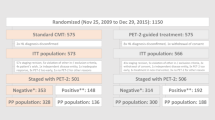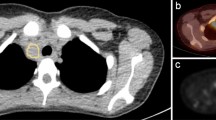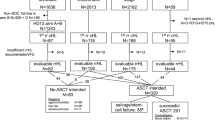Abstract
Positron emission tomography (PET) in conjunction with computed tomography is a frequently used modality for staging patients with lymphoma. Utility of PET-computed tomography before or early following auto-SCT has not been as rigorously evaluated. We retrospectively analyzed patients who received auto-SCT for treatment of relapsed or refractory non-Hodgkins lymphoma or Hodgkins disease between the years of 1996 and 2007. Patients who had either a PET scan following salvage chemotherapy within 14 weeks of transplantation (pre-PET), and/or a PET scan 6–14 weeks following transplantation (post-PET) were included. A total of 90 patients were identified for analysis. The median follow-up time is 3.3 years, with a range of 0.13–12.0 years. The median PFS was 4.6 years, and median OS was 5.1 years. At the time of this analysis, 34 patients (37%) experienced disease relapse, and 25 (27%) of the patients died from disease progression. In multivariate Cox proportional hazards analysis, post-PET did not predict for outcome, pre-PET positivity predicted for decrease in PFS. In conclusion, post-PET scan did not predict for PFS or OS in multivariate analysis. Positive pre-PET scan did predict for PFS as seen in previous studies, and may help identify patients who would benefit from innovative post transplant therapies.
This is a preview of subscription content, access via your institution
Access options
Subscribe to this journal
Receive 12 print issues and online access
$259.00 per year
only $21.58 per issue
Buy this article
- Purchase on SpringerLink
- Instant access to full article PDF
Prices may be subject to local taxes which are calculated during checkout
Similar content being viewed by others
References
Juweid ME, Stroobants S, Hoekstra OS, Mottaghy FM, Dietlein M, Guermazi A et al. Use of positron emission tomography for response assessment of lymphoma: consensus of the imaging subcommittee of international harmonization project in lymphoma. J Clin Oncol 2007, pp 571–578.
Terasawa T, Nihashi T, Hotta T, Nagai H . 18F-FDG PET for posttherapy assessment of Hodgkin's disease and aggressive non-Hodgkin's lymphoma: A systematic review. J Nucl Med 2008, pp 13–21.
Freudenberg LS, Antoch G, Schütt P, Beyer T, Jentzen W, Müller SP et al. FDG-PET/CT in re-staging of patients with lymphoma. Eur J Nucl Med Mol Imaging 2004; 31: 325–329.
Kobe C, Dietlein M, Franklin J, Markova J, Lohri A, Amthauer H et al. Positron emission tomography has a high negative predictive value for progression or early relapse for patients with residual disease after first-line chemotherapy in advanced-stage Hodgkin lymphoma. Blood 2008; 112: 3989–3994.
Hutchings M, Loft A, Hansen M, Pedersen LM, Buhl T, Jurlander J et al. FDG-PET after two cycles of chemotherapy predicts treatment failure and progression-free survival in Hodgkin lymphoma. Blood 2006; 107: 52–59.
Spaepen K, Stroobants S, Dupont P, Van Steenweghen S, Thomas J, Vandenberghe P et al. Prognostic value of positron emission tomography (PET) with fluorine-18 fluorodeoxyglucose ([18F]FDG) after first-line chemotherapy in non-Hodgkin's lymphoma: Is [18F]FDG-PET a valid alternative to conventional diagnostic methods? J Clin Oncol 2001; 19: 414–419.
Naumann R, Vaic A, Beuthien-Baumann B, Bredow J, Kropp J, Kittner T et al. Prognostic value of positron emission tomography in the evaluation of post-treatment residual mass in patients with Hodgkin's disease and non-Hodgkin's lymphoma. Br J Haematol 2001; 115: 793–800.
Torizuka T, Nakamura F, Kanno T, Futatsubashi M, Yoshikawa E, Okada H et al. Early therapy monitoring with FDG-PET in aggressive non-Hodgkin's lymphoma and Hodgkin's lymphoma. Eur J Nucl Med Mol Imaging 2004; 31: 22–28.
Jerusalem G, Beguin Y, Fassotte MF, Najjar F, Paulus P, Rigo P et al. Whole-body positron emission tomography using 18F-fluorodeoxyglucose for posttreatment evaluation in hodgkin's disease and non-hodgkin's lymphoma has higher diagnostic and prognostic value than classical computed tomography scan imaging. Blood 1999; 94: 429–433.
de Wit M, Bohuslavizki KH, Buchert R, Bumann D, Clausen M, Hossfeld DK . 18FDG-PET following treatment as valid predictor for disease-free survival in Hodgkin's lymphoma. Ann Oncol 2001; 12: 29–37.
Mikhaeel NG, Hutchings M, Fields PA, O’Doherty MJ, Timothy AR . FDG-PET after two to three cycles of chemotherapy predicts progression-free and overall survival in high-grade non-Hodgkin lymphoma. Ann Oncol 2005; 16: 1514–1523.
Spaepen K, Stroobants S, Dupont P, Vandenberghe P, Maertens J, Bormans G et al. Prognostic value of pretransplantation positron emission tomography using fluorine 18-fluorodeoxyglucose in patients with aggressive lymphoma treated with high-dose chemotherapy and stem cell transplantation. Blood 2003; 102: 53–59.
Cremerius U, Fabry U, Wildberger J, Zimny M, Reinartz P, Nowak B et al. Pre-transplant positron emission tomography (PET) using fluorine-18-fluoro-deoxyglucose (FDG) predicts outcome in patients treated with high dose chemotherapy and autologous stem cell transplantation for non-Hodgkins lymphoma. Bone marrow transplantation 2002; 30: 103–111.
Svoboda J, Andreadis C, Elstrom R, Chong EA, Downs LH, Berkowitz A et al. Prognostic value of FDG-PET scan imaging in lymphoma patients undergoing autologous stem cell transplantation. Bone Marrow Transplant 2006; 38: 211–216.
Alousi A, Saliba R, Okoroji G-J, Macapinlac HA, Hosing C, Korbling M et al. Disease staging with positron emission tomography or gallium scanning and use of rituximab predict outcome for patients with diffuse large B-cell lymphoma treated with autologous stem cell transplantation. Br J Haematol 2008; 142: 786–792.
Filmont J-E, Gisselbrecht C, Cuenca X, Deville L, Ertault M, Brice P et al. The impact of pre- and post-transplantation positron emission tomography using 18-fluorodeoxyglucose on poor-prognosis lymphoma patients undergoing autologous stem cell transplantation. Cancer 2007; 110: 1361–1369.
Hoppe BS, Moskowitz CH, Zhang Z, Maragulia JC, Rice RD, Reiner AS et al. The role of FDG-PET imaging and involved field radiotherapy in relapsed or refractory diffuse large B-cell lymphoma. Bone Marrow Transplant 2009; 43: 941–948.
Hamlin PA, Zelenetz AD, Kewalramani T, Qin J, Satagopan JM, Verbel D et al. Age-adjusted international prognostic index predicts autologous stem cell transplantation outcome for patients with relapsed or primary refractory diffuse large B-cell lymphoma. Blood 2003; 102: 1989–1996.
Schot BW, Zijlstra JM, Sluiter WJ, van Imhoff GW, Pruim J, Vaalburg W et al. Early FDG-PET assessment in combination with clinical risk scores determines prognosis in recurring lymphoma. Blood 2007, pp 486–491.
Moskowitz CH, Nimer SD, Zelenetz AD, Trippett T, Hedrick EE, Filippa DA et al. A 2-step comprehensive high-dose chemoradiotherapy second-line program for relapsed and refractory Hodgkin disease: analysis by intent to treat and development of a prognostic model. Blood 2001; 97: 616–623.
Harrell Jr FE . Regression Modelling Strategies with Applications to Linear Models, Logistic Regression, and Survival Analysis, 1st edn. Springer: New York, NY, USA, 2001.
Josting A, Franklin J, May M, Koch P, Beykirch MK, Heinz J et al. New prognostic score based on treatment outcome of patients with relapsed hodgkin's lymphoma registered in the database of the german hodgkin's lymphoma study group. J Clin Oncol 2002; 20: 221–230.
Moskowitz CH, Schoder H, Teruya-Feldstein J, Sima C, Iasonos A, Portlock CS et al. Risk-adapted dose-dense immunochemotherapy determined by interim FDG-PET in advanced-stage diffuse large B-cell lymphoma. J Clin Oncol 2010; 28: 1896.
Acknowledgements
We thank Bercedis Peterson, PhD for her assistance in statistical methods.
Author information
Authors and Affiliations
Corresponding author
Ethics declarations
Competing interests
The authors declare no conflict of interest.
Rights and permissions
About this article
Cite this article
Palmer, J., Goggins, T., Broadwater, G. et al. Early post transplant (F-18) 2-fluoro-2-deoxyglucose positron emission tomography does not predict outcome for patients undergoing auto-SCT in non-Hodgkin and Hodgkin lymphoma. Bone Marrow Transplant 46, 847–851 (2011). https://doi.org/10.1038/bmt.2010.203
Received:
Revised:
Accepted:
Published:
Issue date:
DOI: https://doi.org/10.1038/bmt.2010.203
Keywords
This article is cited by
-
Managing Hodgkin lymphoma relapsing after autologous hematopoietic cell transplantation: a not-so-good cancer after all!
Bone Marrow Transplantation (2014)
-
Pre-transplant 18F-fluorodeoxyglucose positron emission tomography-based survival model in patients with aggressive lymphoma undergoing high-dose chemotherapy and autologous SCT
Bone Marrow Transplantation (2013)
-
Pre-transplant FDG-PET-based survival model in relapsed and refractory Hodgkin’s lymphoma: outcome after high-dose chemotherapy and auto-SCT
Bone Marrow Transplantation (2013)



